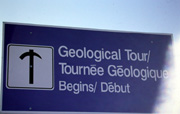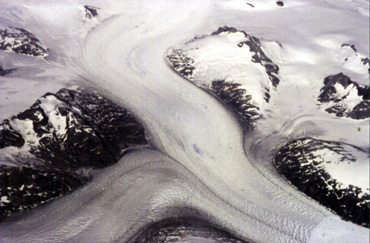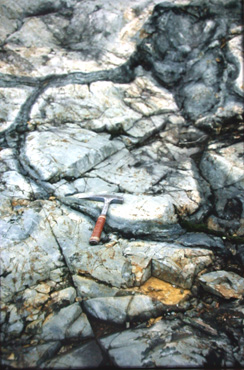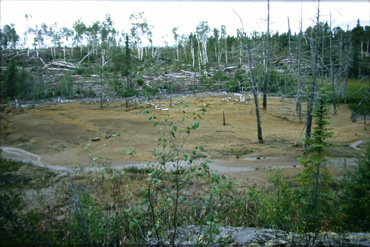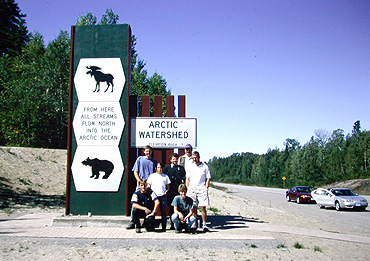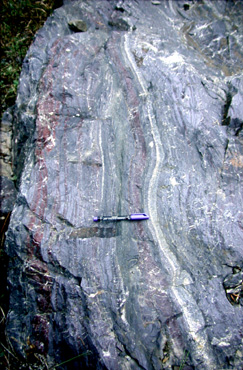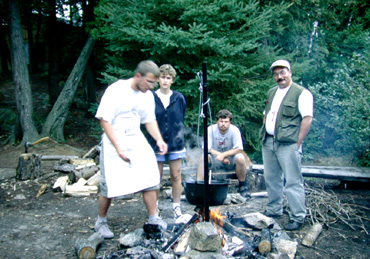| Canadian Shield Field Trip 2001: |
|
||
|
This
report is devoted to present the experiences of the Student Members
from the Eötvös Loránd University SEG Student Chapter, gained at a 2-week
field trip in Ontario, Canada, in August-September 2001. The group comprised
7 third-year students and was accompanied by Dr. Feri Molnár, associate
professor in mineralogy and metallogeny, and Fellow of the Society,
as well as by Krisztián Szentpéteri and Zsolt Hefner, Ph.D. and M.Sc.
students in metallogeny, respectively.
On our arrival in Ottawa, we were friendly welcome by Professor David
Watkinson from the Carleton University, who guided us for the bulk of
our itinerary. We allowed ourselves a day rest and adaptation to time
shift before hitting the highway and heading for the outcrops of the
Grenville Province. Many thanks go to Uncle Paul who provided us with
his wooden house for free, located right at the Calabogie Lake, and
for that he was often there with us, for friendly chats.
During exploration, 39 boreholes were drilled most of which traversed
mafics. Mafics as host rocks are an interesting exception here because
at the world class VMS deposit in Kidd Creek, felsic rocks accommodate
the mineralization. Since the pristine preservation of Archaean hyaloclastite
was possible, an a priori path for ore-forming fluids was produced.
A sulphide crust found around a number of pillows accords with this
idea. At the Canadian Jamieson Mine, located on the same sequence, we
encountered exclusively felsics. These spherulitic rhyolites are enriched
in potassium as it had substituted for sodium, displaying a sericitic
alteration due to submarine hydrothermal activity. This alteration may
reach the stage of kaolinization at different places, and represents,
along with the fairly common occurrence of some quartz-tourmaline-ankerite
veins in adjoining granophyres, a good indicator of pervading fluids.
Another nice example of a VMS deposit was seen at the Kam-Kotia mine.
We got here a true impression what a "massive sulphide" body looks like
as we studied swarms of pyrite+chalcopyrite dykes, neither of them less
than about 1 m in diameter. On the other hand, the mine, which was operated
until 1972, has been labelled the "the worst environmental disaster"
in Ontario.
The third part of our journey took us to the Hemlo-Marathon area. On
half-way to Marathon, near White River, the antiquity of the Cedar Lake
Pluton is exposed. It consists of granodiorites and granites, and was
dated to be 2687 Ga. Important is, of course, whether magmatic thus
ore-forming fluids could have been released or not during crystallization.
This may shed light on a possible relationship of the pluton to the
Hemlo deposits. This presumption was checked and we found pegmatitic
pockets and miarolitic hollows showing a late magmatic fluid enrichment
and segregation. We then made the next stop at Hemlo and had a look
at the giant mining projects. The site comprises 3 mines, which give
20% and 50% of the total Au production of Canada and Ontario, respectively.
It was discovered in 1981 and the production culminated in 1992. Now,
with an average annual production of 1 Moz Au the company has more than
80 years of reserves. The gold may concentrate up to 29 ppm and is 7-8
ppm on the average. Its occurrence is restricted to a E-W-trending zone
of a couple of tens of metres thickness, 1.3 km depth and 2-3 km length.
The zone itself is a contact of an acid volcanic succession and a volcano-sedimentary
sequence. The most auriferous zones are found within porous, tuffaceous
units. Approaching Marathon, one may enjoy a marvellous view of the
Lake Superior.
Much more famous is this area, however, for the Coldwell Complex. It´s
about 1 Ga in age as its formation is a result of the igneous activity
along the Mid-Continental Rift. It covers an area of a few hundred square
kilometres and is made up chiefly of alkaline gabbroidal rocks, associated
with nepheline syenites. Three phases of intrusion can be distinguished,
the younger the event, the more acid the bulk chemistry. Country rocks
are metasediments of the greenstone belt of the Superior Province. Increased
temperature during emplacement of the mafics forced the felsic country
rocks to melt locally; subsequent slow cooling resulted in graphic to
granophyric texture. An intensive volatile mobilization front at the
contact is shown by pronounced biotitization and pegmatite formation.
PGE enrichment is common at the contact. At the deeper parts of the
intrusion there is a well-developed layering consisting of plagioclase-rich
and opaque-rich bands. The plutonic sequence as a whole was associated
with a subvolcanic-volcanic edifice. Although this has been eroded by
now, indirect evidence for its sometime presence is given by cogenetic
xenoliths flopped into the magma chamber, probably due to a catastrophic
collapse. Fragments of both massive and vesicular basalts as well as
various monzonites were found. At the lakeside, we collected a number
of rounded, fresh and exciting cobbles of high-grade metamorphites (and
envisioned in advance the horrible overweight fees at the airport. Progressing
towards Wawa, near Fire Sand Lake, we studied extremely spectacular
pillow basalts, with their pristine structure retained but displaying
a nice metamorphic assemblage of epidote+carbonates+quartz+ferroactinolite.
The age of these rocks scatter around 2.7 Ga. At the same place, right
below a pothole phenomenon, so typical of glaciated regions, we found
a vertical carbonatite dyke half a meter or so in width. Texturally,
it is akin to common orangebrown dolomites and no igneous silicates
were observed. Its formation may be related to the Mid-Continental Rift
and directly linked to the Coldwell Complex, as dating on these rocks
yielded ages of about 1.08 Ga. In general, such bodies, if large enough,
host economically important Nb-Ta and REE mineralization as does, for
example, Oka carbonatite near Ottawa. Therafter, we were prepared to
bump into a kimberlite pipe right around the next corner.
Temagami was the next locality we passed on our way to Cobalt. There,
well-exposed Superior-type BIF was observed. The formation consists
of a monotonous sequence of repetitive alteration of jasperite and iron-rich
bands, all of them ranging 1 to 5 cm in width. It was deposited on the
deeper shelf. The iron-rich bands constitute mostly or exclusively of
magnetite, however, they may have been originally precipitated as hematite.
This type of hematite › magnetite transformation is referred to as musketovitization.
In addition, amphiboles (e.g. antophyllite) and chlorite may show up,
too. The whole sequence was metamorphosed in upper greenschist to amphibolite
facies. Signatures of both brittle and ductile deformation appear, the
most spectacular of them being pinch-and-swell structures on a cm-scale.
The Proterozoic tillites, overlying the Archaean basement, are grouped
together into the Gowganda Formation and are exposed, for example, in
a road bend 4 km south of Cobalt. Hitherto these rocks were known for
us only from the textbooks. These are extremely disorganized, mud-supported
sediments with a high proportion of lithics of various size and material,
being unsorted and chiefly angular. They are interpreted to have been
transported by an ice-sheet and "frozen" as the ice vanished due to
melting. The tillite is unmetamorphosed, reflecting that there have
not been significant orogenic processes in the Laurentian Shield since
Early Proterozoic.
Approaching Cobalt, a dyke of the Nipissing Diabase was observed; picked
out from the topography by erosion and striated by glaciation in agreement
with its 2.2 Ga age. The ore-forming fluids of the Cobalt mineralization
may have been derived from such dykes, however, a different assumption
deals merely with the released heat giving rise to a preexistent reactive
brine to start circulating and thus mobilizing metals from the counrty
rocks. Elements of economic importance are Ni, Co and Ag. Cobalt, as
its name already suggests, owes its establishment to the first prospectors
to seek for orebodies at the very beginning of the 20th century. Interestingly,
the railroad itself was run to this region in order to facilitate the
exploitation of pelitic sediments of outstanding quality in the so-called
Clay Belt. Meanwhile, Ag-rich dykes were discovered, and before long,
a true silver-fever commenced. The mining in the area contributed significantly
to the prosperity of N-Ontario until the 1960s when the last mine was
shut. The most important phases are native, disseminated Ag, safflorite,
cobaltite, breithauptite, bismuthite, arsenopyrite, loellingite. We
toured many of the facilities of the abandoned mine, including wooden
headframes. Along the well-maintained path, a number of boards provided
us with useful information concerning the one-time orebodies, mining
equipments as well as the environmental problems left and proposed solutions
thereof.
After studying the transition from norite to granophyre in the North
Range near the Windy Lake Prov. Park, we drove to the South Range to
have a look at the contact sublayer, the most important economic unit
of the SIC. The sublayer norite is directly underlain by brecciated
rocks of the metamorphic basement, or, Huronian metagranites and metavolcanics.
The norite, or more specifically, the quartz norite is easily recognized
by the splendid blue luster of the quartz grains in it. As mentioned
above, the geometry of the contact often displays marked irregularities,
referred to as embayments. These are places where the orebody seems
to occur, and the Creighton Mine is located onto one of the largest
of such embayments. The brecciation of the basement was produced by
the passage of shock waves. Together with the offsets, it contains the
Ni-Cu-PGE mineralization. Pt+Pd concentrates in the sublayer up to 1-2
ppm. The Copper Cliff offset, the most prominent of its kind, is made
up of quartz diorite. It hosts a substantial fraction of sulphide mineralization,
occurring in the form of blebs and heavily disseminated grains.
Their formation is explained by high temperature immiscibility of silicate
and sulphide liquids. In such a highly convective system, it was not
possible for the sulphides to sink to the bottom and accumulate after
segregation in the form of monosulphide solid solution. Therefore, along
with the cooling and crystallisation of the silicate phases, and increasing
bulk viscosity, the sulphides were forced to remain where they were
produced, however, solid-state transitions from MSS to sincere sulphide
phases took place uninterruptedly. The sulphide blebs are often rimmed
by volatile-rich silicate phases such as micas, epidote and amphiboles.
Most important metals in sulphide bonds are Ni, Cu, Fe and PGE even
though it is not economically worthwhile to concentrate the Fe from
these rocks as there are cheaper places for this purpose. As contrasted
by the sublayer, the offsets may have a Pt concentration up to 10-12
ppm, suggesting that there has been either an injection of an extremely
differentiated sulphide magma or, more probably, a secondary remobilization
has taken place driven by pervasively circulating hydrothermal fluids.
Paricipants of the field trip were: Zsolt Benkó, Emese Gáspár, Zsolt
Hefner, Tamás Mikes, Tamás Pocsai, Szilvia Simon, Krisztián Szentpéteri,
Zsófia Wáczek, Zoltán Zajacz as well as Dr. Feri Molnár. The field trip,
the first one in overseas for the undergraduates of the Eötvös University,
was a resounding success.
|
|||
